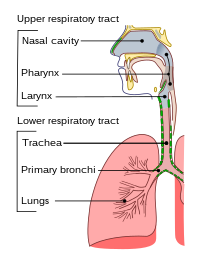
Photo from wikipedia
The dramatic changes in physiology at high altitude (HA) as a result of the characteristic hypobaric hypoxia condition can modify innate and adaptive defense mechanisms of the body. As a… Click to show full abstract
The dramatic changes in physiology at high altitude (HA) as a result of the characteristic hypobaric hypoxia condition can modify innate and adaptive defense mechanisms of the body. As a consequence, few sojourners visiting HA with mild or asymptomatic infection may have an enhanced susceptibility to high-altitude pulmonary edema (HAPE), an acute but severe altitude sickness. It develops upon rapid ascent to altitudes above 2500 m, in otherwise healthy individuals. Though HAPE has been studied extensively, an elaborate exploration of the HA disease burden and the potential risk factors associated with its manifestation are poorly described. The present review discusses respiratory tract infection (RTI) as an unfamiliar but important risk factor in enhancing HAPE susceptibility in sojourners for two primary reasons. First, the symptoms of RTI s resemble those of HAPE. Secondly, the imbalanced pathways contributing to vascular dysfunction in HAPE also participate in the pathogenesis of the infectious processes. These pathways have a crucial role in shaping host response against viral and bacterial infections and may further worsen the clinical outcomes at HA. Respiratory tract pathogenic agents, if screened in HAPE patients, can help in ascertaining their role in disease risk and also point toward their association with the disease severity. The microbial screenings and identifications of pathogens with diseases are the foundation for describing potential molecular mechanisms underlying host response to the microbial challenge. The prior knowledge of such infections may predict the manifestation of disease etiology and provide better therapeutic options.
Journal Title: Briefings in functional genomics
Year Published: 2022
Link to full text (if available)
Share on Social Media: Sign Up to like & get
recommendations!